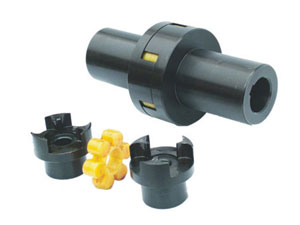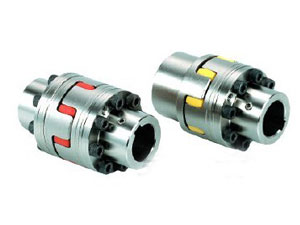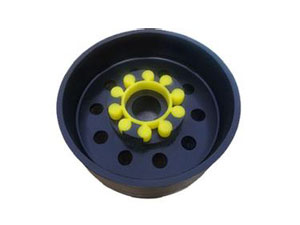Four steps for alignment of diaphragm coupling
The alignment of the diaphragm coupling is divided into four steps.Now let's talk about it in detail.
1. Radial alignment of the coupling
When the diaphragm coupling is aligned, it should be adjusted in the vertical direction.The thickness of the front and rear foot pads can be calculated from the three-point detection data, and the offset of the two shafts can be detected.The diameter of the outer edge of the movable end coupling plus the distance from the outer edge of the coupling to the center of the axial dial gauge rod hole; the distance from the end face of the movable end coupling to the center of the front foot bolt of the movable end; the front of the movable end, The distance between the center of the rear foot bolt.From the above data, the thickness of the front and rear foot pads can be known.If the motor is higher than the fixed end, shims should be reduced; if the motor is lower than the fixed end, shims should be added.
After adjusting the vertical direction, the detection data of each point has changed, it should be reset at the 1 point position, and the data of 2 and 3 points should be measured again.After adjustment, just check whether the sum is within the allowable error range.
2. Alignment of coupling principle
The projection of the circle of the movable end face of the motor on the end face of the fixed end is approximately regarded as a perfect circle, because the distance from the center of the movable end to the end face of the fixed end is unchanged.If you want to meet at the same time, the axis of the movable end and the axis of the fixed end are on the same line, which is just an ideal alignment state.In actual alignment, set the allowable error first, and when the error generated during alignment is within the allowable error range, alignment ends.In many occasions, the lower detection point of the pump cannot be detected, and the alignment work cannot be performed.
3. Steps for correcting the three-point table method
(1) Fix the magnetic fixing seat, the measuring rod and the dial indicator on the couplings of the fixed end and the movable end respectively; (2) Turn the shaft to the 1 o'clock position, and clear the two dial indicators respectively; (3) Then turn the shaft to the 2 o'clock position and read the data; (4) Turn the shaft to the 3 o'clock position and read the data; (5) Calculate separately (6) Loosen the front and rear bolts of the motor, Pad the rear feet with thick gaskets, move the motor to make the two couplings as close as possible, and then tighten the front and rear bolts of the motor, clear the two dial gauges at 1 o'clock, and read at 2 and 3 o'clock. Compare the data with the set allowable error value. If the accuracy requirement is not met, repeat the above steps 2-6; (7) After step 6 is satisfied, loosen the front and rear bolts of the motor slightly, and keep the dial indicator at 3 o’clock Tap the front and rear legs of the movable end, and the middle of the movable end with a copper rod, and perform horizontal alignment until and within the allowable error range; (8) After step 7 is satisfied, tighten the front and rear leg bolts of the movable end , The alignment is over.
4. Axial alignment of the coupling
Alignment in the horizontal direction does not need to calculate the amount of front and rear feet of the movable end, clear the axial and radial dial gauges at 1 o'clock, read the readings of the axial and radial dial gauges at 3 o'clock, and tap with a copper rod The movable end can adjust the axis.Observe the reading of the axial dial gauge first, tap the front and rear feet of the movable end with a copper rod, and adjust the axial reading at 3 o'clock to half of the original.Observe the reading of the radial dial gauge again, tap the middle of the movable end with a copper rod, and adjust the radial reading at 3 o'clock to half of the original.This requires repeated adjustments.The adjustment result should make the sum within the allowable error range.




